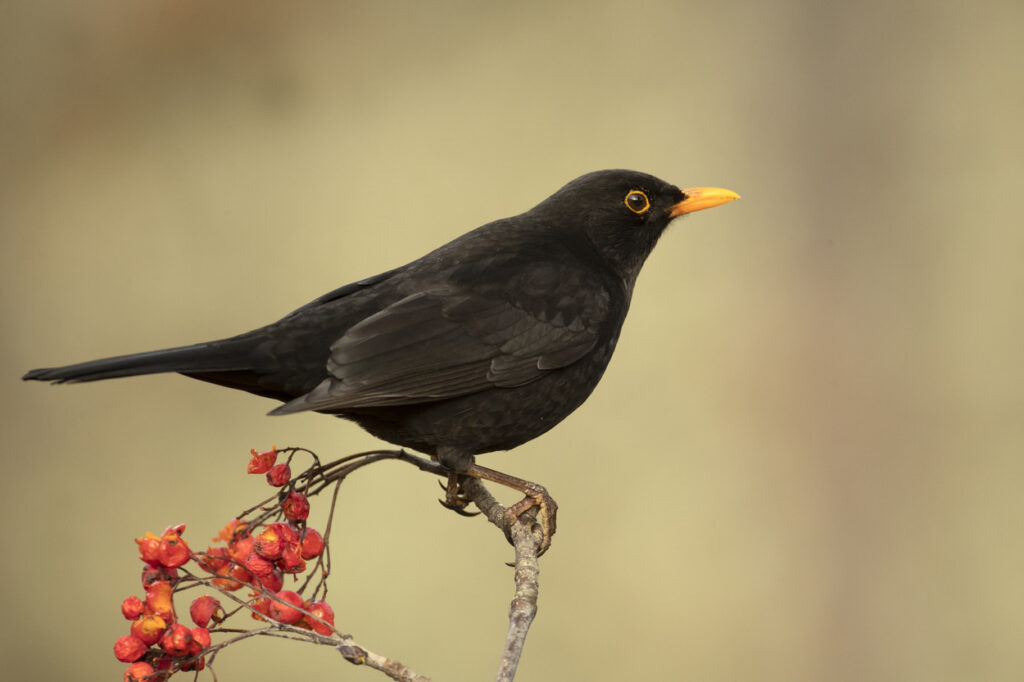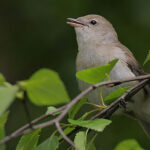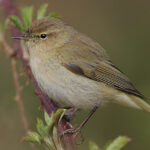Blackbirds are fascinating creatures, found in various parts of the world and known for their distinctive characteristics. Let’s look into 30 intriguing facts about these captivating birds:
- Scientific Name: The common blackbird’s scientific name is Turdus merula.
- Family: Blackbirds belong to the thrush family, Turdidae.
- Distribution: They are widespread across Europe, Asia, and North Africa, and have been introduced to Australia and New Zealand.
- Appearance: Male blackbirds are typically all black with a yellow beak and eye-ring, while females and juveniles are dark brown.
- Size: Blackbirds are medium-sized birds, measuring about 23.5 to 29 cm in length with a wingspan of 34 to 38 cm.
- Diet: Their diet consists mainly of insects, worms, and berries, but they are also known to eat fruits and seeds.
- Song: Blackbirds are celebrated for their melodious song, which males use to establish territory and attract mates.
- Habitat: They are highly adaptable and can be found in woodlands, gardens, parks, and farmlands.
- Nesting: Female blackbirds build cup-shaped nests from grass and mud, usually in dense shrubs or trees.
- Clutch Size: They typically lay 3 to 5 eggs per clutch, which are blue-green with reddish-brown spots.
- Incubation: The incubation period for blackbird eggs is about 13 to 14 days, primarily by the female.
- Fledging: Chicks fledge the nest around 12 to 14 days after hatching but are still fed by parents for several more weeks.
- Lifespan: In the wild, blackbirds can live up to 5 years, though many do not survive their first year.
- Predators: Common predators include cats, birds of prey, and snakes.
- Migration: Some blackbird populations are migratory, particularly those in the northern parts of their range.
- Territorial: Male blackbirds are highly territorial during the breeding season, often seen chasing away rivals.
- Adaptability: Blackbirds are known for their adaptability to urban environments, often seen in city gardens and parks.
- Symbolism: In various cultures, blackbirds are often associated with mystery and omens, both positive and negative.
- Plumage Molt: Blackbirds undergo a complete molt after the breeding season, replacing their feathers for the winter.
- Subspecies: There are several recognized subspecies of blackbirds, each varying slightly in size and coloration.
- Social Behavior: Outside the breeding season, blackbirds can be somewhat social, forming small flocks.
- Cultural References: Blackbirds have been referenced in literature and songs, such as the nursery rhyme “Sing a Song of Sixpence.”
- Foraging: They are primarily ground feeders, often seen hopping on lawns in search of food.
- Conservation Status: The common blackbird is not currently considered endangered and has a stable population.
- Winter Behavior: In winter, blackbirds may change their diet to more fruit-based as insect availability decreases.
- Courtship: During courtship, males perform a series of displays, including tail fanning and bowing.
- Recognition: Blackbirds are capable of recognizing individual humans, particularly those who feed them regularly.
- Communication: Besides their song, blackbirds use various calls to communicate, including alarm calls when predators are nearby.
- Hybridization: Blackbirds can hybridize with other thrush species, though this is relatively rare.
- Research Interest: Blackbirds have been the subject of numerous scientific studies, particularly in the fields of behavior and ecology.
Frequently Asked Questions About Blackbirds
1. What is the scientific name of the common blackbird?
The scientific name of the common blackbird is Turdus merula.
2. What family do blackbirds belong to?
Blackbirds belong to the thrush family, Turdidae.
3. Where can blackbirds be found?
Blackbirds are found across Europe, Asia, and North Africa. They have also been introduced to Australia and New Zealand.
4. What do male and female blackbirds look like?
Male blackbirds are all black with a yellow beak and eye-ring. Females and juveniles are dark brown.
5. What is the size of a blackbird?
Blackbirds measure about 23.5 to 29 cm in length with a wingspan of 34 to 38 cm.
6. What do blackbirds eat?
Blackbirds primarily eat insects, worms, and berries, but they also consume fruits and seeds.
7. Why are blackbirds known for their song?
Blackbirds are celebrated for their melodious song, which males use to establish territory and attract mates.
8. What type of habitats do blackbirds prefer?
Blackbirds are highly adaptable and can be found in woodlands, gardens, parks, and farmlands.
9. How do blackbirds build their nests?
Female blackbirds build cup-shaped nests from grass and mud, usually in dense shrubs or trees.
10. How many eggs do blackbirds lay?
Blackbirds typically lay 3 to 5 eggs per clutch.
11. How long is the incubation period for blackbird eggs?
The incubation period for blackbird eggs is about 13 to 14 days.
12. When do blackbird chicks fledge?
Blackbird chicks fledge the nest around 12 to 14 days after hatching.
13. What is the lifespan of a blackbird?
In the wild, blackbirds can live up to 5 years, though many do not survive their first year.
14. Who are the predators of blackbirds?
Common predators of blackbirds include cats, birds of prey, and snakes.
15. Do blackbirds migrate?
Some blackbird populations are migratory, particularly those in the northern parts of their range.
16. Are blackbirds territorial?
Yes, male blackbirds are highly territorial during the breeding season.
17. Can blackbirds adapt to urban environments?
Blackbirds are known for their adaptability to urban environments, often seen in city gardens and parks.
18. What cultural symbolism is associated with blackbirds?
In various cultures, blackbirds are often associated with mystery and omens, both positive and negative.
19. Do blackbirds molt?
Yes, blackbirds undergo a complete molt after the breeding season.
20. Are there different subspecies of blackbirds?
Yes, there are several recognized subspecies of blackbirds, each varying slightly in size and coloration.
21. Are blackbirds social birds?
Outside the breeding season, blackbirds can be somewhat social, forming small flocks.
22. How are blackbirds referenced in culture?
Blackbirds have been referenced in literature and songs, such as the nursery rhyme “Sing a Song of Sixpence.”
23. How do blackbirds forage for food?
Blackbirds are primarily ground feeders, often seen hopping on lawns in search of food.
24. What is the conservation status of the common blackbird?
The common blackbird is not currently considered endangered and has a stable population.
25. How does a blackbird’s diet change in winter?
In winter, blackbirds may change their diet to more fruit-based as insect availability decreases.
26. How do blackbirds perform courtship?
During courtship, males perform a series of displays, including tail fanning and bowing.
27. Can blackbirds recognize individual humans?
Yes, blackbirds are capable of recognizing individual humans, particularly those who feed them regularly.
28. How do blackbirds communicate besides singing?
Besides their song, blackbirds use various calls to communicate, including alarm calls when predators are nearby.
29. Can blackbirds hybridize with other species?
Blackbirds can hybridize with other thrush species, though this is relatively rare.
30. Why are blackbirds of interest to researchers?
Blackbirds have been the subject of numerous scientific studies, particularly in the fields of behavior and ecology.





